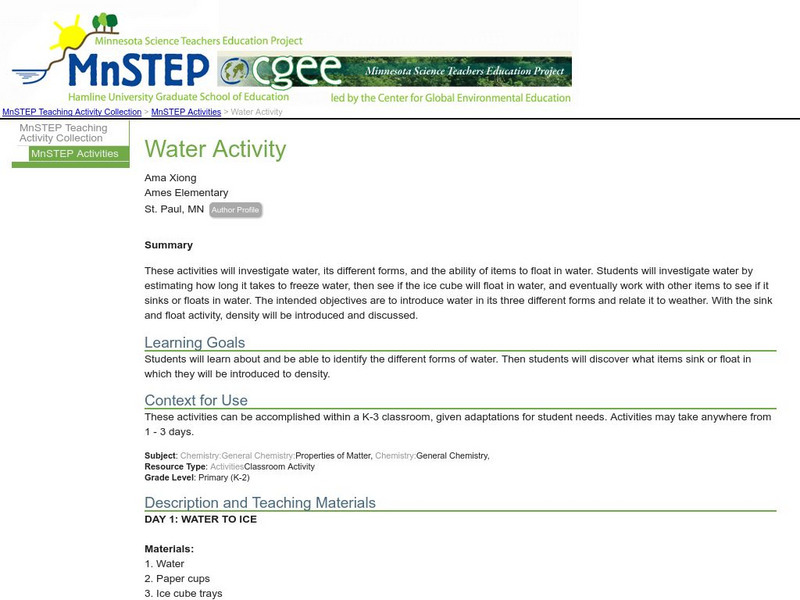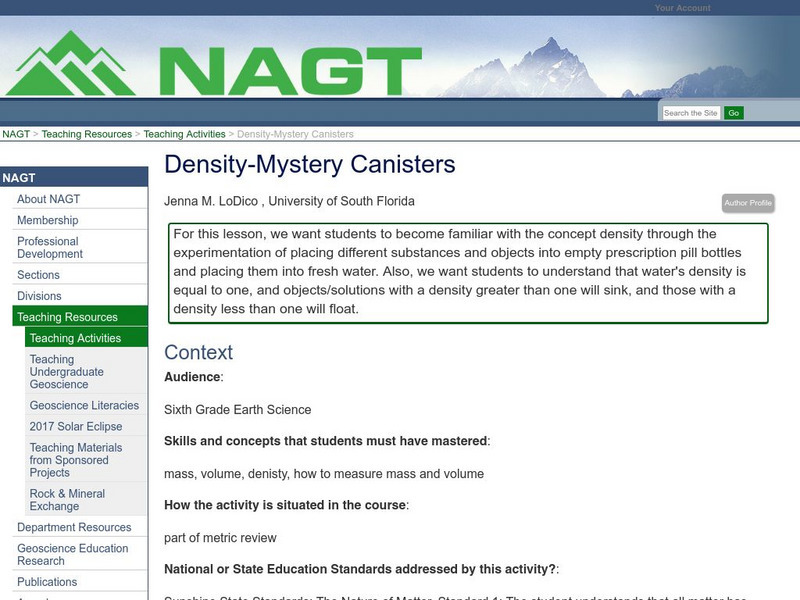Hi, what do you want to do?
Curated OER
i-Density Crisis
Eighth graders determine the density using mass and volume. In this science lesson plan, 8th graders explain why some materials float or sink. They estimate the density of objects based on whether it floats or sinks in a liquid of...
Curated OER
Introduction to Density
Seventh graders define density in their own words. In this physics lesson, 7th graders solve density problems using its mathematical formula. They explain why some objects flow and some sink.
Curated OER
Trash Traits: Marine Debris, Litter, Ecology, Oceans
Learners perform experiments to examine whether trash can float, blow around, or wash away. The effects of these characteristics on the presence of marine debris in the environment are then discussed.
Curated OER
Marine Debris
Students will perform experiments to examine if debris will float, or blow in the wind. They discuss the effects of these characteristics on marine debris.
Curated OER
How Wet Can You Get?
Students visit a swimming pool and brainstorm different water sports and what benefits swimming has over other types of exercise. They then discuss buoyancy and water pressure and when how objects sink or float before playing a game of...
Curated OER
Introduction to Density
Seventh graders discover the definition of density through a demonstration using ethanol and ice cubes and a class discussion using a SMART Board to illustrate formulas and calculations. Students finish the lesson by practicing...
Curated OER
Regular Coke versus Diet Coke, Which is Denser?
Young scholars investigate the density of liquids. For this geometry lesson, students calculate the volume and differentiate between volume, mass and density. They observe similarity and differences between coke and diet coke.
Curated OER
The Wonderful world of Water
First graders examine the water cycle through readings and experiments. In groups, they conduct interviews with others and use the information to create a chart displaying the various uses of water. After brainstorming lists of ways to...
Curated OER
Preschoolers and Science Skills
You can encourage critical thinking and problem solving by allowing young children to participate in hands-on science activities.
Curated OER
Do You Know Bamboo?
Students understand the properties of Bamboo and what it can be used for. In this bamboo lesson, students with bamboo and compare and contrast to wood. Students share their findings.
Curated OER
The Letter Ww
Students explore letter Ww. In this letter recognition lesson, students participate in country, state, food, literature, physical education, colors, careers, music, and game activities that are linked to the main lesson page. Students...
Curated OER
The Letter Ff: Alphabet Theme
Students complete several cross-curricular activities to learn the letter Ff. In this letter recognition lesson, students complete activities that include geography, music, physical education, science, seasonal, space science, and online...
Curated OER
Buoyant Force
Students illustrate Archimedes' Principle of Buoyant Force. In this graphing lesson, students will observe that the buoyant force on an object is equal to the weight of the fluid it displaces. Students will then create a graph showing...
Curated OER
Feeding Frenzy
Students are divided into two teams in which its members are to gather as many objects in the pool as possible gaining points for different objects.
Curated OER
How Dense Are You?
Students examine how density is a value that describes what type of a material an object is made of regardless of its shape or size.
Curated OER
Wetlands/Watershed Model
Students work together to create a watershed model. They discover the flow of surface water on different topography. They examine how materials originate from miles away and end up in a different wetland.
Curated OER
How Do We Breathe?
Students study the structure of the lungs. For this lung structure lesson, students use lung models to study the structure of lungs and experiment to measure the amount of air in the lungs.
Science Education Resource Center at Carleton College
Serc: Water Activity
Students investigate water by estimating how long it takes to freeze, then see if the ice cube will float in water, and eventually work with other items to see if they sink or float in water.
Alabama Learning Exchange
Alex: Float or Sink?
Young scholars will define density and use the density formula to determine the density, volume, and mass of various items using the correct units for each measurement.
Utah Education Network
Uen: 1st Grade Act. 24: Interactive Writing
In this lesson, students will listen to nonfiction books about items that sink and float. Students will participate in filling in words to fill in a teacher-created chart that is connected to the information. Students will then write a...
National Association of Geoscience Teachers
Nagt: Density Mystery Canisters
Students experiment with items that sink or float, and learn that water's density is equal to one, and objects/solutions with a density greater than one will sink, and those with a density less than one will float.
CK-12 Foundation
Ck 12: Chemistry Simulation: Going Fishing
[Free Registration/Login Required] Students will be able to change the mass and volume of an item and observe if it floats, sinks, or remains at a certain depth in the water. Students will also be able to change the liquid in level 2.


























